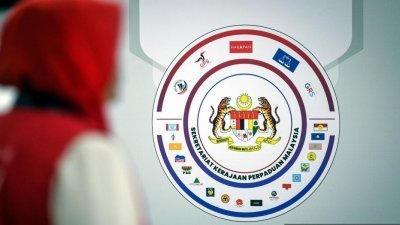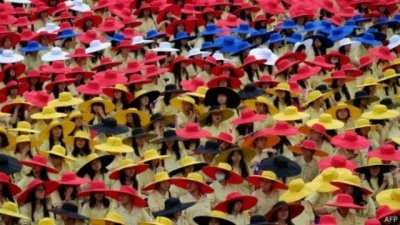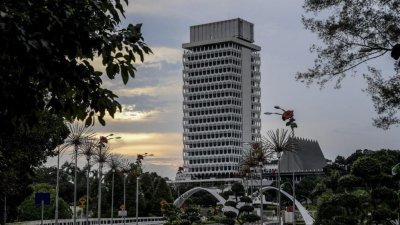从各种军事统计数据(如下表)可以清楚看出,在任何可能发生的战争中,美国在大多数(如果不是全部)领域都比中国拥有压倒性优势。无论是在核武、军舰、潜水艇、战机或军用卫星方面,单单美国一国——没有计算西方盟友、台湾,可能还有日本和印度下——其拥有资源远超越中国。

同时,美国的军事能力也逐年增强。最新报告显示,美国的国防开支比中国、俄罗斯、印度、沙地阿拉伯、英国、德国、法国、韩国、日本和乌克兰的总和还要多。2022年美国国防开支为8700亿美元/4.09兆令吉,而中国估计为2300亿美元/1.08兆令吉,中国相比下相形见绌。
美国也是世界最大的军火生产国和销售国。2018年至2022年间,美国占全球军火市场的40%。作为在印太地区对抗中国而成立的四方安全对话(QUAD)组织成员国日本和澳洲,是美国最大的军购客户,而台湾在蔡英文总统领导下,在拜登执政期间也购买了价值数十亿美元的军备。
同时,目前加沙和乌克兰的战争也令美国军工产业忙碌起来,并确保支持它们的政治和军事游说团体获得巨额酬劳。这也让美国“国防”公司的投资者高兴。
亚洲地区的任何战争无疑都会为美国和西方军工复合体带来巨大回报。
尽管中国拥有庞大的工业和制造能力,但其武器出口量位居世界第四,仅次于美国、俄罗斯和法国,估计只占市场5.2%或美国出口量的1/8。
这些数字(如下表)不言自明地说明了美国和中国哪个国家的军事化程度较高,哪个国家正在煽动战争,对世界造成痛苦和带来苦难。

美国围堵中国
美国政客和军事领导人不满足于现有军事优势,正试图夸大中国的军事能力和开支,以作为美国进一步增加军事开支借口。
尽管不断的透过炒作中国挑战美国军事霸主地位来散布恐慌,但众所周知,美国在世界各地,特别是在亚洲地区都有其军事足迹和议程。
70多年来,美国在印太地区实施了旨在反映美国军事力量的“第一岛链”安全网络。最初是在第二次世界大战结束后和1951年朝鲜战争爆发后针对苏联,现在主要针对中国,美国将中国海岸线视为潜在敌方领土。
第一岛链的中点和关键部分位于台湾,美国决策者普遍称之为“不沉的航空母舰”。
此外,美国也开发了第二条安全岛链,由日本、菲律宾、澳洲和密克罗尼西亚群岛组成。与第一岛链一样,目标是中国。
这两个岛链内驻扎著数十万美军人员。美国国会最近的一份报告显示,目前有37.5万名美军人员驻扎在印太地区66个不同的“防御性”军事设施中。
相较之下,中国只拥有一个外国军事基地——不是在亚洲,而是在非洲吉布提。
一切证据都表明,中国的军事实力和能力远远不如美国。
同时,中国领导人多次宣称,中国无意挑战或取代美国在本区域的地位。
无论如何,这不意味著,如果美国决定对付中国,或中国认为其国家利益和在本区域地位受到威胁时,中国会是软柿子。
因此,今天的中国两大奋斗目标,一是在2027年时将人民解放军打造成“世界一流军队”,二为2049年实现“中华民族伟大复兴”。
中国不断增长的技术实力和核武库能否足以阻止美国发动战争,尤其美国领导人正急于挑起这场战争,因为他们担心美国很快就会丧失军事上优势。
为此,美国也开辟了打压中国的新战线。
美国商务部长雷蒙多日前在加州西米谷举行的年度国防论坛上发表演说时,要求立法者、矽谷和美国盟友阻止中国获得对美国国家安全至关重要的半导体和尖端技术。
她说中国是“我们所遇到的最大威胁”,并强调“中国不是我们的朋友”。
“中国每天醒来都试图找出如何绕过我们的出口管制......这意味著每天的每一分钟,我们都必须加强这些控制,并更加认真地与我们的盟友一起执行。”
她没有说的是,她每天醒来都会做关于中国崛起和强大的噩梦,也许其床边的华为手机铃声会唤醒她的战斗力。
雷蒙多和那一些沉迷于战争的同僚应该意识到,美国和中国之间在任何战线上的战争——无论是军事、商业、贸易还是经济——都不会只有中国是输家。
美国即使胜出,也将付出惨痛代价。
林德宜《中国能否在印太战争中对抗美国》原文:Can China Take On The US In An Indo Pacific War

It is clear from various military statistics that the United States has an overwhelming superiority over China in most if not all spheres of any likely war. Be it in nuclear weaponry, warships, submarines, military aircraft or military satellites, the US alone - without its allies in the West, and Taiwan and possibly Japan and India, - has the resources to outshoot China.
At the same time, the military capacity of the US is increasing every year. Latest reports show that the United States spends more on national defence than China, Russia, India, Saudi Arabia, United Kingdom, Germany, France, South Korea, Japan, and Ukraine combined. US defence expenditure of US$870 billion in 2022 dwarfed that of China's estimated US$230 billion.
The US is also the world’s leading armament producer and salesman. The US accounted for 40% of the total volume of international arms transfers between 2018–2022. Japan and Australia, members of the QUAD set up to counter China in the Indo Pacific region, are the US biggest weapons customers while Taiwan under President Tsai Ing-Wen has purchased several US$ billion worth of weaponry during Biden’s administration.
Meanwhile, current wars in Gaza and Ukraine are keeping US armament factories busy and ensuring big pay cheques for the political and military lobbies supporting them. They are also keeping investors in US ‘defence’ companies happy.
Any war in the Asian region will undoubtedly produce enormous returns to the US and western military industrial complex.
China, despite its enormous industrial and manufacturing capability, ranks fourth in the world in armament exports after US, Russia and France, with an estimated 5.2%, or one-eighth of the US volume.
These figures speak for themselves as to which country - the US or China - is a more militarised one, and which country is instigating wars and causing suffering and misery in the world.

US Encirclement of China
Not satisfied with military superiority, US politicians and military leaders are engaging in new attempts to inflate China’s military capability and expenditure so as to justify further increases in US spending.
Despite these efforts aimed at scare mongering through hyping the China challenge to US military supremacy, everyone knows that the US has its military boot print and agenda all round the world but especially in the Asian region.
Within the Indo-Pacific region, the US has for more than 70 years implemented a “first island chain” security network aimed at projecting US military power. Initially directed against the Soviet Union after the end of the 2nd world war and following the outbreak of war in Korea in 1951, it is now aimed primarily against China whose coastline the US considers as potential enemy territory.
The midpoint and key part of this first island chain is to be found in Taiwan which is popularly referred to by American policy makers as their “unsinkable aircraft carrier”.
In addition, a second American security island chain has been developed with Japan, the Philippines, Australia and the islands of Micronesia as components. As with the first chain, the target is China.
Within these two island chains are stationed hundreds of thousands of US military personnel. A recent US congressional report revealed that 375,000 US military personnel are presently based in 66 distinct ‘defence’, that is, military installations in the Indo Pacific region.
In contrast, China has one foreign military base - not in Asia but in Djibouti, Africa.
All evidence shows conclusively that China’s military capacity and capability is far inferior to the US.
At the same time, Chinese leaders have repeatedly declared that China has no intention to challenge or unseat the American position in the region.
This does not mean that China will be a sitting duck or easy target should the US decide to take on China and what China regards as its national interest and legitimate position in the Asian region.
Hence China today is in the midst of two major campaigns to turn its People’s Liberation Army (PLA) into a “world-class military” by 2027 and to achieve “national rejuvenation” by 2049.
Will China’s growing technological prowess and nuclear arsenal be sufficient to deter US from the war which members of the American leadership are eagerly provoking, and which they are in a hurry to initiate for fear that US military superiority will be lost soon.
Meanwhile, the US has opened up new fronts to take down China.
Speaking at an annual national defence forum in Simi Valley in California, US Commerce Secretary Gina Raimondo asked lawmakers, Silicon Valley and US allies to stop China from getting semiconductors and cutting-edge technologies key to national security
She said China is "the biggest threat we've ever had" and stressed that "China is not our friend".
"Everyday China wakes up trying to figure out how to do an end run around our export controls... which means every minute of every day, we have to wake up tightening those controls and being more serious about enforcement with our allies."
What she did not say is that she wakes up every day having had nightmares on the rise and development of China, and perhaps with a Huawei handphone by her bedside ringing to wake her up to do battle.
Raimondo and her war obsessed colleagues should realise that any war between the US and China on any front - whether military, commercial, trade or economy - will not see only China as the loser.
The US, even if it wins, will also pay a heavy price.
要看最快最熱資訊,請來Follow我們 《東方日報》WhatsApp Channel.












.jpeg/1ca669875f96342e68954c5eba0f9246.jpeg)





